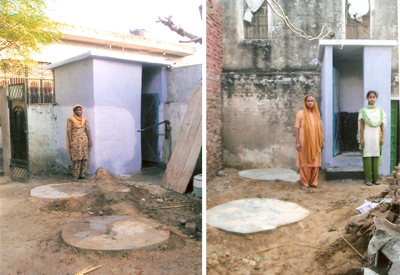
Making Inroads (or Raising Barriers?) With Sewers in Punjab
Co-blogged by Sundari and Camille.
 While many LangarHall moments are spent bringing awareness to adverse issues impacting our community, we believe it is equally important to highlight solutions to these problems. There are several people and organizations who are working to improve the social development and health of communities around the world. One example of a simple yet life changing initiative is a toilet. Yes, toilets. A facility taken for granted by many and something that over 2 million people around the world are in need of. The Punjab Lioness Toilet Foundation was created to provide awareness of communities in need of basic toilet and sanitation facilities,
While many LangarHall moments are spent bringing awareness to adverse issues impacting our community, we believe it is equally important to highlight solutions to these problems. There are several people and organizations who are working to improve the social development and health of communities around the world. One example of a simple yet life changing initiative is a toilet. Yes, toilets. A facility taken for granted by many and something that over 2 million people around the world are in need of. The Punjab Lioness Toilet Foundation was created to provide awareness of communities in need of basic toilet and sanitation facilities,
As a family initiative the Punjab Lioness Toilet Foundation wants to empower people to take action in providing basic toilet needs to less fortunate families in Punjab, India. The foundation was started in the memory of our late mother Pritam Kaur Bahia who passed away on November 18th, 2004. She was known as the “Sherni” a.k.a. Lioness. [link]
Founded by Mandip Kaur Sandher, one of the goals of the organization is to break the “toilet taboo,” which comes from people’s lack of comfort speaking about a subject which they consider dirty. This stigma is impacting global health and as a result, basic sanitation needs for hundreds and thousands of people around the world.
The Punjab Lioness Toilet Foundation is not simply about building toilets. The goal is to bring awareness to the need for sanitation, empower “Indian families including Sikhs to take action” and to connect people to the right information and resources. Many people living in the diaspora send money back home for various reasons (let’s put a helicopter replica on the roof!). However, what the Punjab Lioness Toilet Foundation addresses is the need to invest in the development of villages. For example, do the schools in the village have adequate toilet facilities? As with many global health issues, women and children are especially impacted by the lack of sanitation facilities,
700,000 children die every year due to diarrhea and dehydration caused by poor hygiene. Many schools in rural India do not have toilets and this is one of the main reasons why girls dropout from school once they cross the primary level. [link]
Does your family send money back to Punjab? Is the money invested into the infrastructure of the village/pindh? The United Nations declared 2008 as the International Year of Sanitation. However, more active efforts are needed to address this very important global health issue. The 2015 Millennium Development Goals have slated a target that toilets should be provided to half (of the 2.6 millions people without appropriate sanitation facilities) by 2015 and to all by 2025.
After all, sanitation is dignity.
——————————–
Another take on infrastructure inequality is that the West is obsessed with toilets, often to the exclusion of providing enhanced sanitation. In his article, Deep Democracy: Urban Governmentality & the Horizon of Politics, Arjun Appadurai refers to this obsession as the “politics of shit.” What Appadurai focuses on is the disconnect between the expectations and solutions of the middle and upper classes (both within India but also internationally), as opposed to the core needs, concerns, and solutions that may be advanced by poor communities. Specifically, Appadurai reviews an award-winning development intervention that sought to recover its costs for installing toilets and engaging in “slum beautification” on areas of Mumbai.
Within a year, the entire project was an epic failure, with “cost-recovering” measures pricing out participation from slum residents, resulting in an undersubscription to their new toilets, which led to raw sewage immersing the slum. The disconnect, he argues, was between upper class advocates who believed the key solution to sanitation concerns was “beautification” and toilets, while the poor residents of the slum may have had different interests, potential solutions, or goals.
There is no doubt that rural and poor communities suffer disproportionately from infrastructural inequality, particularly as it relates to sanitation, and the connection between poor sanitation and water-borne diseases (such as dysentary) is clear. However, the (technical) cure in this case may be worse than the cause. As development economists have discussed, rapid infrastructural infill — such as the establishment of toilets — is not always the most effective way to address sanitation problems.
The Lioness Foundation is taking on an important and often overlooked basic need. However, I am less convinced that its focus on toilets — which are often expensive, require intricate waste systems, and rely on routine technical upkeep — is the key to ensuring improved rural sanitation, decreased disease incidence, and increased women’s empowerment. Perhaps the Foundation’s core work, which includes highlighting sanitation concerns and engaging in consciousness-raising, should allow for a reassessment and evaluation of the efficacy of its program.














Teachers also feel very relaxed by using technologies. Because they are able to deliver the lectures to the students very effectively and their efficiency of delivery lecture also increases.